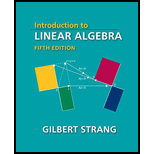
(a) To Show:
Given information:
Concept used:
Transpose of matrix means row and column of matrix gets interchanged.
Proof:
So, we get the matrix
We will show that
We will simplify the vector
So, we get
Conclusion:
(b) To show:
If
Given information:
Concept used:
Transpose of matrix means row and column of matrix gets interchanged.
Proof:
So, we get the matrix
We will simplify the vector
So, we get
Conclusion:
If
(c) To determine:
Find three independent eigenvectors of
Eigenvectors as
Given information:
Concept used:
Transpose of matrix means row and column of matrix gets interchanged.
Proof:
So, we get the matrix
To get eigenvalues, we will solve the equation
The above condition gives the following equation
As equation
So by choosing different values of these variables we get the following solutions.
So, we get the eigenvectors as
Conclusion:
Eigenvectors as
Want to see the full answer?
Check out a sample textbook solution
Chapter 6 Solutions
Introduction to Linear Algebra, Fifth Edition
 Algebra and Trigonometry (6th Edition)AlgebraISBN:9780134463216Author:Robert F. BlitzerPublisher:PEARSON
Algebra and Trigonometry (6th Edition)AlgebraISBN:9780134463216Author:Robert F. BlitzerPublisher:PEARSON Contemporary Abstract AlgebraAlgebraISBN:9781305657960Author:Joseph GallianPublisher:Cengage Learning
Contemporary Abstract AlgebraAlgebraISBN:9781305657960Author:Joseph GallianPublisher:Cengage Learning Linear Algebra: A Modern IntroductionAlgebraISBN:9781285463247Author:David PoolePublisher:Cengage Learning
Linear Algebra: A Modern IntroductionAlgebraISBN:9781285463247Author:David PoolePublisher:Cengage Learning Algebra And Trigonometry (11th Edition)AlgebraISBN:9780135163078Author:Michael SullivanPublisher:PEARSON
Algebra And Trigonometry (11th Edition)AlgebraISBN:9780135163078Author:Michael SullivanPublisher:PEARSON Introduction to Linear Algebra, Fifth EditionAlgebraISBN:9780980232776Author:Gilbert StrangPublisher:Wellesley-Cambridge Press
Introduction to Linear Algebra, Fifth EditionAlgebraISBN:9780980232776Author:Gilbert StrangPublisher:Wellesley-Cambridge Press College Algebra (Collegiate Math)AlgebraISBN:9780077836344Author:Julie Miller, Donna GerkenPublisher:McGraw-Hill Education
College Algebra (Collegiate Math)AlgebraISBN:9780077836344Author:Julie Miller, Donna GerkenPublisher:McGraw-Hill Education





